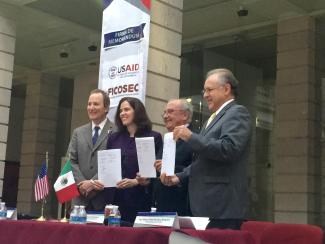Development cooperation between the United States and Mexico began before USAID was created. The first formal agreement between the two governments to provide development assistance was through the Mutual Security Act of 1951. During that time, the United States focused on health programs, academic exchanges between U.S. and Mexican universities, food security, housing guarantees, and innovative models of entrepreneurship.
In 1961, President John F. Kennedy signed into law the Foreign Assistance Act, which led to the creation of USAID as the lead agency for all foreign assistance programs. USAID officially began work in Mexico as a continuation of the development programs under the Mutual Security Act, expanding its assistance to include economic growth, technology transfers, disaster relief, and democratic governance.
Between 1965 and 1977, USAID did not implement programs in Mexico following a global realignment of assistance efforts. It was not until the late 1970s that USAID resumed its development programming, focusing on population and family planning. Within two years of USAID’s re-entry into Mexico, USAID became the lead donor in the health and population sector, providing assistance across virtually every program area, including service delivery, information services and communication, data collection and analysis, training, operations research, and contraceptive supplies.
A difficult but important moment for American foreign assistance in Mexico occurred in response to the 1985 earthquake. An earthquake measuring 8.1 on the Richter scale killed more than 4,000 people in Mexico City. The U.S. response to the tragedy was immediate and massive. Within a week, over 1,000 U.S. disaster assistance personnel from a dozen United States Government agencies, local government, and private institutions were in Mexico City. First Lady Nancy Reagan and USAID Administrator Peter McPherson also visited to express their sympathy for and solidarity with the people of Mexico. USAID demonstrated a tremendous capacity to deliver rapid, essential, and substantial humanitarian aid at a moment of great need.
The strong cooperation between the United States and Mexico has produced some key successes over the course of the bilateral relationship. One major success includes the establishment of the Mexican Conservation Fund, which was a new concept whereby funds, for the first time, were placed in an institution that the Government of Mexico did not control. Subsequently, a multidisciplinary group of 21 environmental specialists, receiving joint funding from the United States and the Government of Mexico, carried out an extensive consultation process with over 250 conservation organizations in Mexico. The result was three additional Mexican conservation funds, including the protection of the Meso-American Reef and the Gulf of California. The model has been replicated by more than 20 countries around the world and is now an international best practice.
Another successful model of cooperation includes USAID’s support of exchanges between Mexican and other governments to share information on various best practices to address common development challenges. USAID also invested in university and state-level partnership programs to support scholarships for indigenous populations. Other examples of collaboration include U.S. support to the Mexican Government to control tuberculosis outbreaks along the U.S.-Mexico border, the training of Mexican personnel in wildfire suppression, management of hazardous materials, and natural disaster management.
Today, Mexico is among USAID’s most self-reliant partner countries, the world’s 15th largest economy, and a functioning liberal democracy with high levels of capacity. In USAID’s 2021 Country Roadmap, Mexico exhibits high levels of commitment to trade freedom, business environment, and biodiversity and habitat protection. It scores high in its capacity related to child health, civil society and media effectiveness, and export sophistication. The Mission continues to actively engage Mexico’s private sector through strategic alliances that encourage innovation and leverage resources to increase program impact, enhance sustainability, and replicate successful interventions across the country.
USAID selected the Country Development Cooperation Strategy (CDCS) 2020-2025 Goal of “U.S.-Mexico Strategic Partnership Advanced through Mutual Security and Prosperity” to accentuate that this is a relationship of peers, not of a donor and a recipient, focused on challenges of strategic interest and mutual benefit to both countries, where burden-sharing is evident and foreign assistance can add value.

Indira Villegas / USAID
